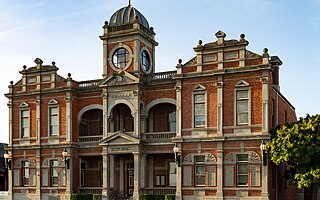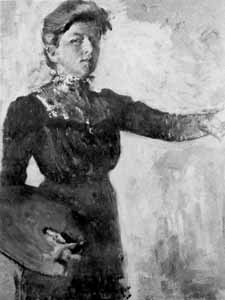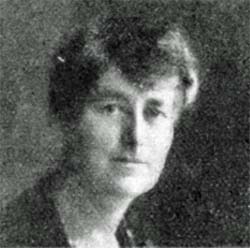
The National Gallery of Victoria, popularly known as the NGV, is an art museum in Melbourne, Victoria, Australia. Founded in 1861, it is Australia's oldest and most visited art museum.

The Victorian Artists Society, which can trace its establishment to 1856 in Melbourne, promotes artistic education, art classes and gallery hire exhibition in Australia. It was formed in March 1888 when the Victorian Academy of Arts and the Australian Artists' Association amalgamated.

Castlemaine is a town in Victoria, Australia, in the Goldfields region about 120 kilometres northwest by road from Melbourne and about 40 kilometres from the major provincial centre of Bendigo. It is the administrative and economic centre of the Shire of Mount Alexander. The population at the 2021 Census was 7,506. Castlemaine was named by the chief goldfield commissioner, Captain W. Wright, in honour of his Irish uncle, Viscount Castlemaine.

The Royal Exhibition Building is a World Heritage-listed building in Melbourne, Victoria, Australia, built in 1879–1880 as part of the international exhibition movement, which presented over 50 exhibitions between 1851 and 1915 around the globe. The building sits on approximately 26 hectares, is 150 metres (490 ft) long and is surrounded by four city streets. It is at 9 Nicholson Street in the Carlton Gardens, flanked by Victoria, Carlton and Rathdowne Streets, at the north-eastern edge of the central business district. It was built to host the Melbourne International Exhibition in 1880–81, and then hosted the even larger Centennial International Exhibition in 1888, and the formal opening of the first Parliament of Australia in 1901. The building is representative of the money and pride Victoria had in the 1870s. Throughout the 20th century smaller sections and wings of the building were subject to demolition and fire; however, the main building, known as the Great Hall, survived.

Clarice Marjoribanks Beckett was an Australian artist and a key member of the Australian tonalist movement. Known for her subtle, misty landscapes of Melbourne and its suburbs, Beckett developed a personal style that contributed to the development of modernism in Australia. Disregarded by the art establishment during her lifetime, and largely forgotten in the decades after her death, she is now considered one of Australia's greatest artists.

Alice Marian Ellen Bale, known as A.M.E. Bale, was an Australian artist.
Harriet Edquist is an Australian curator, and Professor of Architectural History in the School of Architecture and Design at RMIT University in Melbourne. Born and educated in Melbourne, she has both published widely on and created numerous exhibitions in the field of Australian architecture, art and design history. She also contributes to the production of Australian architectural knowledge as editor of the RMIT Design Archives Journal and is a member of the Design Research Institute at RMIT University.

Elsie Frederica Barlow, was an Australian painter and printmaker. She was a founding member of Twenty Melbourne Painters. She was also the first woman to have a solo exhibition in Castlemaine, Victoria.

Polly Hurry, was an Australian painter. She was a founding member of the Australian Tonalist movement and part of the Twenty Melbourne Painters Society.

Henrietta Maria Gulliver was an Australian artist who specialized in landscape and floral still-life paintings. She was also a florist, horticulturalist and landscape designer.

Bertha Merfield (1869–1921) was an Australian painter and muralist. She was a founding member of the Twenty Melbourne Painters Society.
Robyn Stacey is an Australian photographer and new media artist known for her large striking still lifes.
Christian Marjory Emily CarlyleWaller(Yandell) (2 August 1894 - 25 May 1954) was an Australian printmaker, illustrator, muralist and stained-glass artist. At 15 she moved to Melbourne, where she studied at the National Gallery School. In 1915 she married fellow-student Mervyn Napier Waller.
Josephine Margaret Muntz Adams was an Australian artist who distinguished herself as a portraitist. Her portrait of Duncan Gillies, 14th Premier of the state of Victoria (1886-1890), hangs in Parliament House, Melbourne. Her portrait of the Queensland and Australian Federal politician Charles McDonald is in Parliament House, Canberra.
Lucy Colgate Newell was an Australian artist noted for painting and textile printing.
Dawn Sime, who was also known as Dawn Frances Sloggett and Dawn Westbrook, was an abstract painter who was part of the expressionist movement in Melbourne in the late 1950s and 1960s. A pioneer of abstraction at the time, she was among only a few in the field She spent most of her life in Melbourne and died in Castlemaine.
Trefor Prest is a Welsh-born Australian sculptor living in Victoria since 1961. He produces highly-finished intricate and puzzling, often humorous, quasi-mechanical or machine-age constructions that are the subject of solo shows in major public and commercial galleries and feature in national and international group exhibitions, including the Mildura Sculpture Triennials.

Castlemaine Art Museum is an Australian art gallery and museum in Castlemaine, Victoria in the Shire of Mount Alexander. It was founded in 1913. It is housed in a 1931 Art Deco neo-classical building constructed for the purpose, heritage-listed by the National Trust. Its collection concentrates on Australian art and the museum houses historical artefacts and displays drawn from the district.
Alexander Colquhoun was a Scottish-born Australian painter, illustrator and art critic.

Anna Mary Winifred Brotherton (1874–1956), better known as Winnie Brotherton, was the founder of the Castlemaine Art Museum, a Red Cross volunteer, Girl Guide leader, and botanical collector who corresponded with Ferdinand Mueller.















